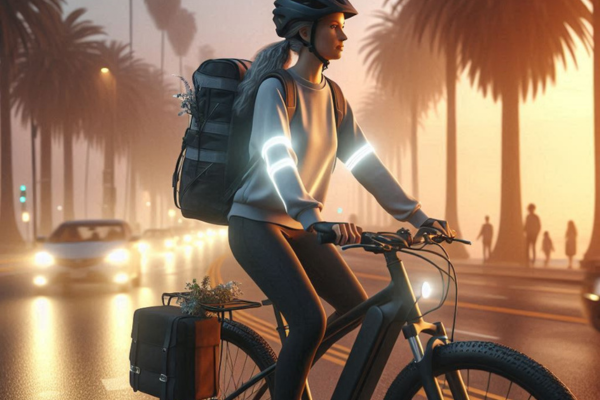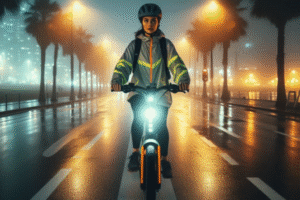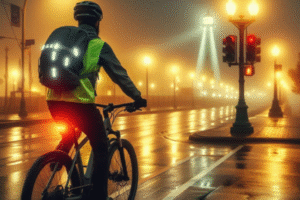✨ Reflective Clothing That Actually Looks Good (and Keeps You Safe) in Coastal Cities
When you’re cruising down the waterfront at sunrise or weaving through foggy streets near the boardwalk, staying visible on your e-bike isn’t just smart—it’s essential. In coastal cities, where morning mist, ocean glare, and unpredictable weather mix with pedestrian-heavy zones, your presence on the road needs to be more than just functional—it needs to stand out. But what if you could stay safe and look great doing it?
Reflective clothing has long been associated with neon vests, construction-worker yellow, and bulk. Yet, modern urban cyclists—especially those in beachside environments—are demanding more: garments that blend fashion with functionality, visibility with versatility. Whether you’re commuting through Cartagena’s humid harbor lanes or crossing a roundabout near the cliffs of San Diego, your outfit shouldn’t just reflect light—it should reflect you.
🌊 Why Reflective Gear Matters More in Coastal Settings
Riding in coastal cities presents visibility challenges that inland commuters don’t always face. The presence of moisture in the air, diffused light during dawn or dusk, and salty sea breezes can reduce the sharpness of your silhouette. This makes it harder for drivers, pedestrians, and other riders to see you—especially during early morning or late evening rides when the beach is still waking up or winding down.
- Humidity and salt can dull colors and reduce contrast, making traditional gear less effective over time.
- Sea mist and coastal fog scatter light, making headlamps less visible and outlines harder to define.
- Tourist traffic adds unpredictability—visitors may be unfamiliar with local cycling infrastructure or distracted by the scenery.
Reflective clothing that performs well in this setting needs to shine through these challenges—not just reflect light, but cut through environmental noise.
🧥 Rethinking Style and Safety
For years, cyclists had to choose between looking good and staying safe. But brands today are finally stepping up, offering reflective apparel that fits like streetwear but performs like safety gear. Think tailored jackets with discreet reflective panels, sleek vests with 360° visibility, and even casual hoodies that glow under headlights without looking like highlighter ink.
In beachside cities, this matters more than ever. When you jump off your e-bike and walk into a café, surf shop, or coworking space, your gear shouldn’t scream “utility”—it should blend into your lifestyle. Coastal cycling fashion now prioritizes:
- Breathable fabrics that resist salt corrosion and dry quickly after morning mist.
- Reflective designs integrated into patterns and logos—not just taped onto sleeves.
- Convertible pieces like jackets that turn into shoulder bags or hats with hidden reflectivity.
💡 Tip: In coastal cities, your wardrobe is part of your safety strategy. Choose pieces that can handle fog, reflect from multiple angles, and still look great once you’ve locked up your bike by the beach.
In the next block, we’ll explore specific types of reflective clothing and accessories—what works best in humid, breezy conditions, and how to build your visibility kit from head to toe without compromising style. 🌴🚴♀️✨
🧢 From Head to Toe: Reflective Apparel That Shines in Coastal Conditions
Reflective gear is not just a one-size-fits-all solution—especially in humid, wind-swept coastal cities. The right clothing must adapt to salt air, wet surfaces, warm breezes, and occasional downpours. But that doesn’t mean sacrificing your style or individuality. The key is to select pieces that serve double duty: they reflect light in low visibility and keep you feeling fresh, confident, and climate-ready by the coast.
👕 Essential Reflective Clothing for Coastal Commuters
Let’s break down your visibility arsenal. Each piece below plays a role in maximizing your presence on the road—and yes, you can build your outfit to look great in both cycling mode and café-stop mode.
| Garment | Functionality | Why It Works in Coastal Cities |
|---|---|---|
| Reflective windbreaker jacket | Lightweight, blocks sea breeze, with 360° reflectivity | Perfect for foggy mornings and sudden gusts near harbors |
| Moisture-wicking long sleeve with reflective trim | Breathable, slim-fit for layering | Keeps you dry and cool in high humidity zones |
| Convertible reflective vest | Folds into a pouch, adjustable fit | Easy to carry and wear during sunrise/sunset rides |
| Reflective cap or helmet cover | Increases head visibility, rain-resistant | Useful in areas with frequent marine drizzle |
🌬️ Don’t Forget the Coastal-Specific Details
In coastal regions, your gear needs to work a little harder. Here are some often overlooked factors when choosing your reflective clothing:
- Salt-resistance: Zippers, stitching, and fabric coatings should withstand salt exposure without degrading.
- Quick-dry properties: Even early morning humidity can soak through inferior materials.
- Ventilation zones: Look for mesh underarms or back vents to stay cool when the sun breaks through fog.
🧍♀️ Layered Visibility Is Smarter Visibility
The best visibility setups include multiple reflective points at different heights and angles. Combine a jacket with wristbands or ankle cuffs, and consider reflective shoe accents or socks for nighttime effect—especially in poorly lit coastal intersections.
💡 Tip: Salt, sun, and sea breeze can wear down even premium gear. Rinse reflective clothing occasionally with fresh water and store it in a dry, shaded place to preserve performance and style.
In the next block, we’ll cover reflective **accessories and gear enhancements**—from LED strips to reflective backpacks—that add function and fashion to your coastal riding experience. 🧳💡
🎒 Reflective Accessories That Boost Visibility (and Style) in Coastal Environments
Reflective clothing is essential, but true visibility comes from layering—especially when you ride near the sea. Coastal environments pose extra challenges: wet conditions dull reflectivity, sand accumulates on shoes and gear, and soft morning light makes low-contrast details hard to detect. That’s why accessories like packs, bands, and add-ons are vital to complete your look and safety system.
From sleek LED-integrated backpacks to subtle reflective piping on messenger bags, today’s e-bike commuter doesn’t have to choose between functional and fashionable. These accessories enhance your presence without looking like emergency gear—and work seamlessly in the casual-chic style of coastal urban cycling.
🧾 Smart Reflective Accessories for Every Coastal Ride
Use this checklist to ensure your setup covers all key visibility zones—especially helpful in cities where intersections can be foggy, narrow, or shared with tourist foot traffic.
- ✅ Reflective backpack or pannier with integrated panels or LED lights
- ✅ Reflective ankle straps or pant clips that move as you pedal—highly visible in low light
- ✅ Reflective gloves for signaling turns in high-contrast visibility
- ✅ Helmet with reflective stickers or rear LED light for 360° head-level visibility
- ✅ Spoke reflectors or rim tape for side visibility—especially in fog-prone beach areas
- ✅ Compact reflective vest or sash for emergency use or nighttime commutes
The beauty of these accessories is their flexibility: you can combine and rotate them based on time of day, destination, and weather.
🌧️ Designed for Coastal Durability
Unlike standard urban accessories, coastal-ready reflectors need to resist salt, sand, and moisture. That means:
- Waterproof materials that won’t absorb mist or ocean spray
- Rust-proof zippers and clips that hold up on humid morning rides
- UV-resistant fabrics to prevent fading from constant exposure to coastal sun
Many brands now offer recycled or eco-conscious reflective materials—perfect for riders who care about protecting the coastline they ride beside.
💡 Subtle Reflectivity That Blends with Your Style
If your aesthetic leans minimalist, you can still ride smart. Look for:
- Reflective logos or branding patches
- Hidden reflective flaps that reveal during motion
- Black-on-black reflectivity that glows only when hit by headlights
These options keep your outfit stylish off the bike, while still catching attention on foggy intersections or dusky harbor roads.
💡 Tip: Layer your reflectivity like layers of sunscreen—head, torso, legs, and motion zones. In coastal cities, visibility is a moving target. Make your movement the message.
In Block 4, we’ll cover how to build an outfit that transitions from the bike path to the beach café, maintaining style, comfort, and top-tier visibility in every seaside scenario. 🌴🚦☕
👕 Coastal Outfits That Transition Seamlessly from Bike Lane to Beach Café
In coastal cities, your e-bike outfit isn’t just for cycling—it’s your all-day look. You might start your day navigating foggy marina intersections and end it sipping espresso at a beachside café or checking emails from a coworking spot with sea views. That’s why reflective clothing in these settings must be adaptable, breathable, and fashion-forward, without sacrificing safety or comfort.
Thankfully, you no longer have to dress like you’re headed to a construction site to stay visible. Many modern garments are made for dual purpose: keeping you safe in traffic and making you feel great when off the saddle.
☕ What Makes a Great Coastal Cycling Outfit?
You need an ensemble that balances three core pillars: visibility, breathability, and style versatility. Whether you’re riding along boardwalk boulevards or stepping into a relaxed surf-themed shop, your outfit should work with the coastal vibe—not against it.
- Lightweight materials that breathe in humidity and dry fast from light ocean mist or sweat.
- Subtle reflectivity that appears under headlights but blends into your streetwear style during the day.
- Layering options that allow easy shedding or adding as marine conditions change throughout the day.
- Easy packability so you can stow your windbreaker or sash in a small bag when stepping inside a shop or office.
🧢 Outfit Example: The Coastal Commuter Look
Here’s a versatile outfit that works perfectly in coastal environments and provides layered visibility:
- Top: Lightweight long-sleeve shirt with UV protection and hidden reflective strips along the arms and collar. Choose pale blue, soft green, or ocean gray to stay within beach tones.
- Outer layer: Sleeveless reflective vest with breathable mesh back—easy to pack away once you arrive at your destination.
- Bottoms: Stretch-fit commuter pants with ankle reflectivity and stain-resistant fabric to handle salt or sand splashes.
- Footwear: Slip-on shoes with reflective heel tags—ideal for biking and walking into shops without clunky cleats.
- Accessories: Crossbody bag with integrated reflective piping, a mesh cap with glowing panels, and subtle reflective wristbands.
🌬️ Dressing for Changing Coastal Conditions
Morning fog, midday sun, and late afternoon breeze are all possible in a single day near the coast. Prepare for shifts in climate without compromising your visibility:
- Start layered in the morning and peel back as the temperature rises—reflective undershirts still keep you visible even without your jacket.
- Pack a neck gaiter that doubles as sun protection or wind barrier near open-water intersections.
- Use color strategically—pastel and ocean tones stay cool and calm but still offer high contrast in foggy conditions.
💡 Tip: In coastal life, your ride doesn’t end at the curb. Dress for both visibility and social versatility so you feel just as confident walking into the café as you did crossing the marina intersection.
And now, in our final block, we’ll wrap up with common questions, closing advice, and a call to our coastal cycling community to shine together—on the road and beyond. 🌎🚴♀️✨
💬 Frequently Asked Questions (FAQs)
1. Is reflective clothing still effective in coastal fog?
Yes, and even more important! In foggy coastal areas, reflective materials help distinguish your outline when natural contrast is low. The key is to use multi-directional reflectivity—on your upper body, arms, and legs—to cut through soft ambient light.
2. Do I need to wear reflective clothing during the day?
Absolutely. Coastal glare and backlighting can obscure your presence. Even subtle reflective threads or trims improve your visibility to drivers navigating seaside curves or pedestrian-heavy boardwalks.
3. What if I don’t like wearing bright or fluorescent colors?
You don’t have to. Many brands now offer stylish reflective options in neutral, muted, or pastel tones that reflect under light but remain subtle in daylight. Black-on-black reflectivity and ocean-hued gear work beautifully in coastal settings.
4. How can I stay visible when my route includes tunnels or shaded palm-lined areas?
Use layered reflectivity. Reflective gloves, ankle bands, and helmet lights are ideal for low-light tunnels or tree-covered coastal routes. Motion-based reflectivity—like your pedaling legs—stands out especially well in dappled shade.
5. What’s the best way to clean reflective clothing exposed to salt air?
Rinse with fresh water after long rides along salty paths or piers. Avoid bleach or harsh detergents. Hang dry in the shade to protect reflective surfaces from UV fading and extend the garment’s life.
💖 Final Thoughts: Shine With Purpose, Not Just Light
In coastal cities, where sunlight dances on the water and fog rolls in without warning, being visible isn’t just practical—it’s a kindness. It protects you. It helps drivers. It respects the rhythm of shared streets.
Reflective clothing isn’t about standing out for attention—it’s about showing up with intention. It’s about saying: “I’m here, I’m aware, and I’m riding smart for myself and for others.” And when that safety blends with your own personal style? That’s when you truly shine.
💡 Tip: Visibility is not a trend. It’s a commitment to yourself, your community, and your coastal lifestyle. Wear it proudly.
🌴 Join the Conversation from the Coast
Do you ride along coastal boulevards in the early mist? Have you found reflective gear that fits your look and your needs? Your tips, experiences, and style favorites could help another rider stay safe—and stylish—on the same foggy path.
Share with us in the comments:
🧥 What’s your go-to reflective item for beachside commutes?
🌤️ How do you balance comfort and safety in warm, humid climates?
💬 Have you ever had a moment when being seen truly saved your ride?
Let’s keep building a community that moves smart, rides safe, and reflects the best of coastal cycling—one visible ride at a time. 💛🌊🚴♀️



